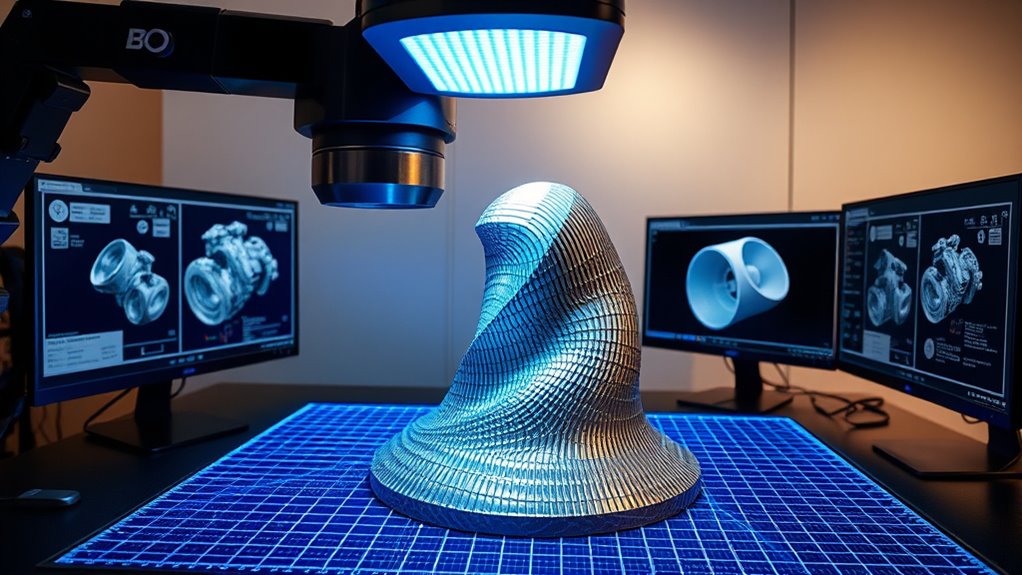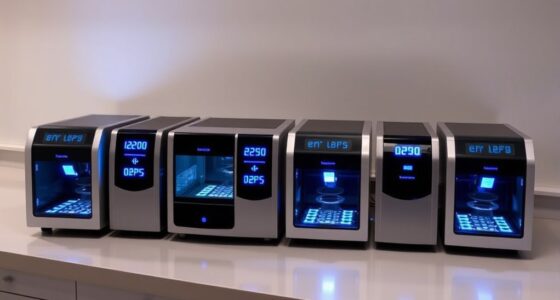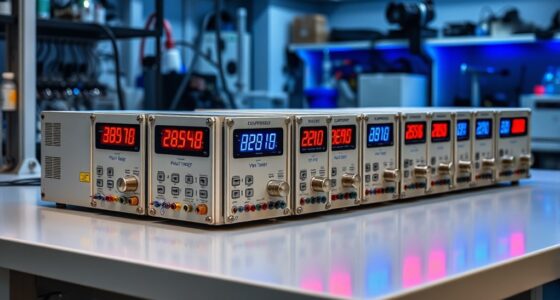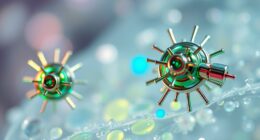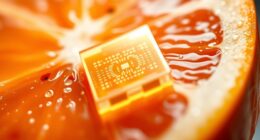If you’re looking for the best high-resolution 3D scanners for precision in 2025, I recommend considering options like the Creality Raptor Pro, which offers 0.02mm accuracy, and the Shining 3D Einstar for ultra-realistic, full-color scans. The Creality CR-Scan Ferret and Einstar Pro also excel in speed and detail, making them perfect for professional needs. Keep exploring, and you’ll discover more top picks that fit your specific requirements.
Key Takeaways
- High-precision scanners like Creality Raptor Pro and Einstar deliver accuracy down to 0.02mm for detailed, professional-quality 3D capture.
- Advanced features such as AI tracking, marker-based stitching, and rapid data processing ensure seamless, high-speed scans of complex objects.
- Full-color, high-resolution textures provide realistic, lifelike models suitable for art, design, and industrial applications.
- Portable, user-friendly designs with wireless connectivity and broad compatibility enable efficient outdoor and on-the-go scanning.
- Top models in 2025 offer a balance of high resolution, speed, and reliable software support, catering to professional metrology and detailed reconstruction needs.
Creality 3D Scanner Raptor Pro
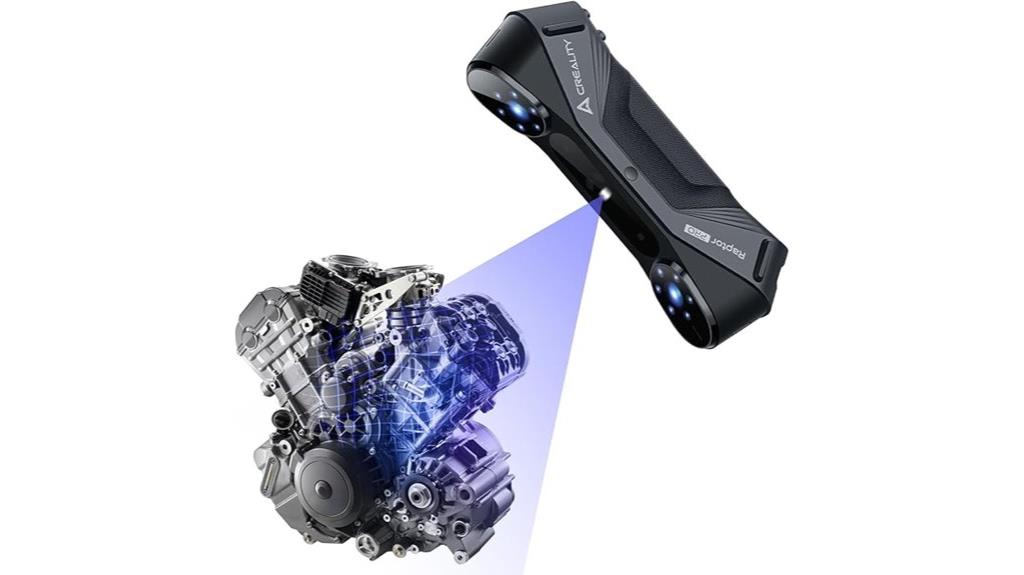
If you’re looking for a high-precision 3D scanner capable of handling medium to large objects with metrology-grade accuracy, the Creality 3D Scanner Raptor Pro is an excellent choice. It uses 22 cross laser lines and 7 parallel blue laser lines for efficient scanning, with each line only 0.1mm thick. The scanner captures data at up to 60 fps, processing 660,000 points per second for quick, detailed results. Its lightweight design, weighing just 405 grams, includes a robust metal lens barrel and a 2.3MP camera. Perfect for automotive and engineering projects, it balances speed, accuracy, and portability for professional applications.
Best For: professionals in automotive, engineering, and industrial fields seeking high-precision, portable 3D scanning solutions for medium to large objects.
Pros:
- Metrology-grade accuracy with 0.02mm precision suitable for detailed professional projects
- Fast data capture at 60 fps, processing 660,000 points per second for efficient scanning
- Lightweight and durable design, weighing only 405 grams, for easy portability and stable handheld operation
Cons:
- Software usability issues, including calibration difficulties and a clunky interface
- Extensive permissions required for mobile device connectivity can be cumbersome
- Higher price point near $2000 may be a barrier for casual or beginner users
Shining 3D Einstar Handheld 3D Scanner
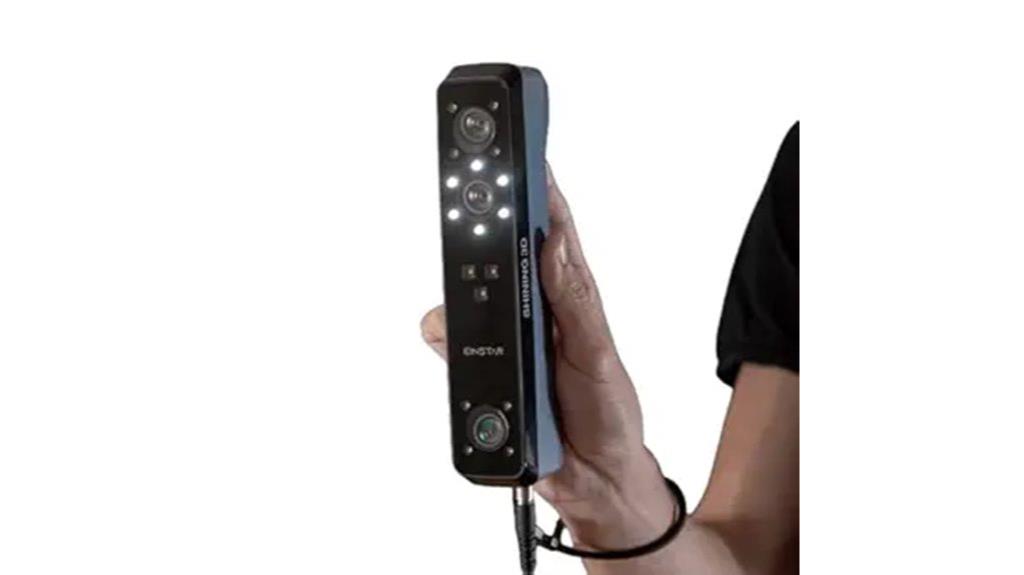
The Shining 3D Einstar Handheld 3D Scanner stands out for its rapid scanning speed of up to 14 FPS, making it ideal for professionals who need quick, high-resolution data capture. It supports detailed scans of hair and bodies with a point distance of up to 0.1mm, ensuring precision. The built-in RGB camera delivers rich color fidelity, while intelligent software enhances detail and guides users for better results. Its user-friendly design includes a safe, projector-free operation and Hair Mode for better hair data. Equipped with multiple cameras and infrared projectors, it performs reliably outdoors, offering versatile outputs suitable for 3D printing, AR, VR, and digital archiving.
Best For: professionals and enthusiasts seeking rapid, high-resolution 3D scanning for detailed objects, including hair and human bodies, suitable for 3D printing, digital archiving, and AR/VR applications.
Pros:
- High-speed scanning up to 14 FPS for efficient data collection
- Supports detailed hair and body scans with 0.1mm point distance for precision
- Safe, projector-free operation with a user-friendly interface and intelligent software enhancements
Cons:
- Requires compatible software and hardware setup for optimal use
- May be less suitable for very large objects due to working distance limitations
- Higher cost compared to entry-level 3D scanners
Creality CR-Scan Ferret Pro 3D Scanner
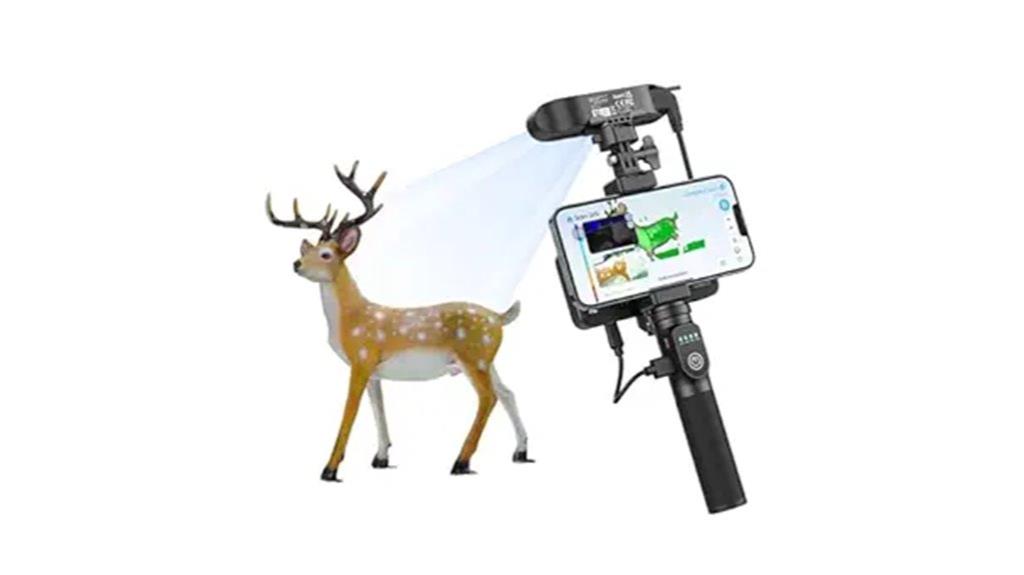
For professionals seeking high-quality, full-color 3D scans of medium to large objects, the Creality CR-Scan Ferret Pro stands out thanks to its rapid, accurate, and wireless performance. It captures detailed textures with a 2MP color camera and achieves 0.1mm accuracy at 60FPS, making it ideal for objects like cars and tires. Its One-Shot imaging technology guarantees stabilization even outdoors in bright sunlight. Compatible with Windows, Mac, iOS, and Android, it uses WiFi 6 for fast data transfer. The package includes essential accessories, and Creality offers around-the-clock support, making it a versatile choice for professional scanning needs.
Best For: professionals and hobbyists seeking high-precision, full-color 3D scans of medium to large objects like cars and tires with fast wireless performance.
Pros:
- Rapid 3D scanning with 0.1mm accuracy at 60FPS ensures detailed and precise models.
- Full-color texture capture with a 2MP camera provides realistic, vibrant textures.
- Wireless connectivity via WiFi 6 offers fast, stable data transfer compatible with multiple operating systems.
Cons:
- Some users report performance limitations or quality issues, indicating potential variability in results.
- The device may be relatively expensive compared to entry-level scanners.
- Compatibility and setup might require technical knowledge, especially for seamless integration with software.
Einstar Handheld 3D Scanner Pro
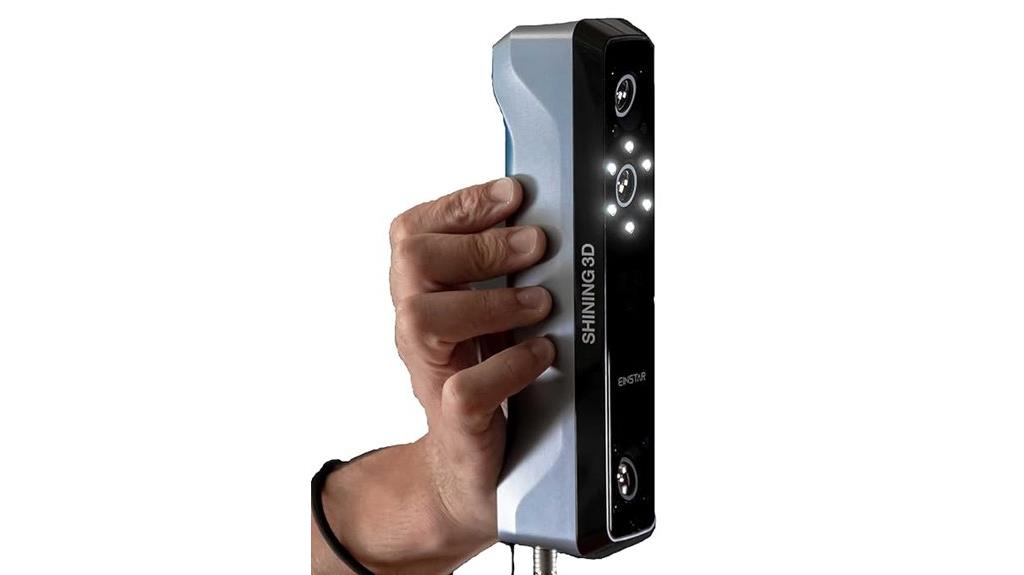
The Einstar Handheld 3D Scanner Pro stands out for its combination of high-resolution, full-color scanning, making it ideal for professionals and enthusiasts who need detailed, realistic models on the go. Weighing less than 1kg, its ergonomic design makes it easy to handle during portable scans without external markers or complex setups. Equipped with infrared VCSEL structured light and a high-quality RGB camera, it captures ultra-realistic, full-color details at resolutions up to 0.1mm. Compatible with Windows 10 and macOS Ventura, it supports multiple file formats. While it requires practice and proper environment to achieve best results, it offers a versatile, industry-grade solution for diverse applications.
Best For: Professionals and enthusiasts seeking portable, high-resolution, full-color 3D scanning for detailed models in design, art, or preservation projects.
Pros:
- Ultra-realistic, full-color scans with high resolution up to 0.1mm
- Portable ergonomic design weighing less than 1kg, ideal for on-the-go use
- Supports multiple file formats and compatible with Windows 10 and macOS Ventura
Cons:
- Achieving optimal results requires practice, calibration, and suitable environmental conditions
- Inconsistent scanning performance on complex geometries or reflective surfaces reported by some users
- Advanced software learning curve for first-time users and occasional technical issues affecting usability
Creality Raptor Pro 3D Scanner, High-Precision 0.02mm
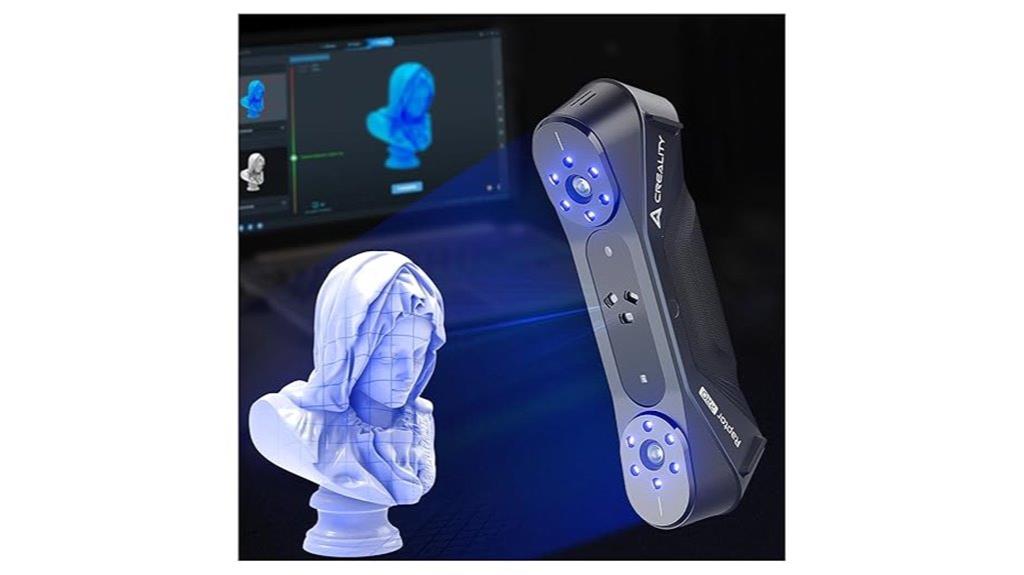
If you need a high-precision 3D scanner capable of detailed industrial inspections or reverse engineering, the Creality Raptor Pro is an excellent choice. It delivers metrology-grade accuracy up to 0.02mm, using advanced blue laser technology for precise data capture. With a scan speed of 660,000 points per second and multiple laser modes, it handles objects from tiny 5mm to large 4000mm sizes. Its versatile scanning options include laser, infrared structured light, and facial mapping. While hardware feels durable, users often face software stability issues, calibration challenges, and operational quirks that can hinder consistent results.
Best For: professionals and hobbyists needing high-precision 3D scans for industrial inspection, reverse engineering, or detailed modeling of objects ranging from small parts to large structures.
Pros:
- Metrology-grade accuracy up to 0.02mm ensures highly detailed and precise scans.
- Versatile scanning modes including laser, infrared structured light, and facial mapping accommodate various applications.
- Fast scan speeds of 660,000 points per second enable efficient data capture and processing.
Cons:
- Frequent software crashes, bugs, and stability issues can hinder workflow and reliability.
- Calibration and tracking can be difficult, leading to inconsistent results and difficulty merging scans.
- User interface is clunky and unintuitive, complicating editing and project management.
Creality CR Scan Ferret Pro 3D Scanner
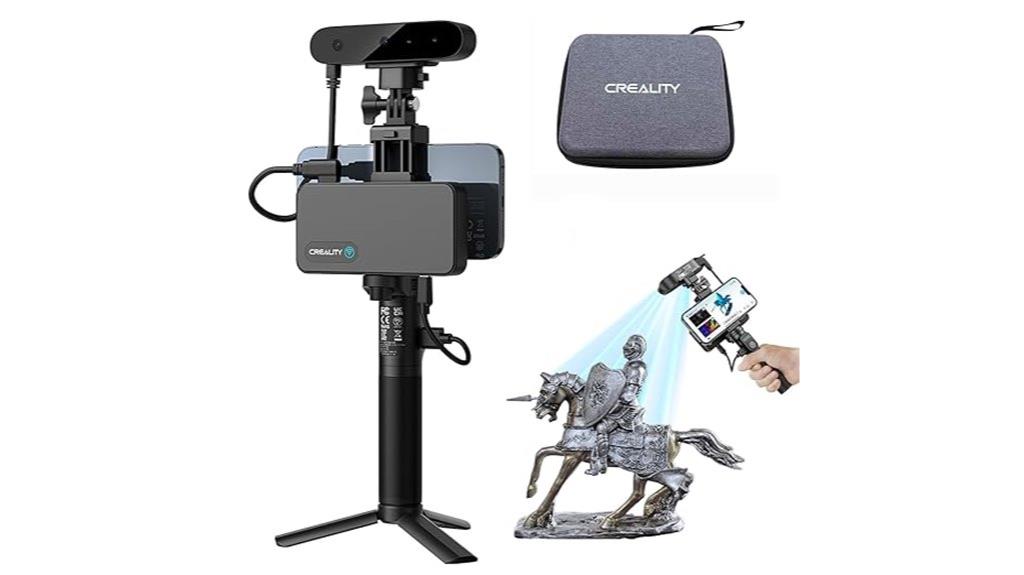
Creality CR Scan Ferret Pro 3D Scanner stands out with its high-precision, full-color capture, making it an excellent choice for professionals and enthusiasts who demand detailed, realistic models. It achieves 0.1mm accuracy with a 24-bit color depth, thanks to its high-resolution camera and advanced face mapping algorithms. Its anti-shake technology guarantees stable scans, even on challenging surfaces like dark or metallic objects. The lightweight, portable design (105 grams) allows outdoor and indoor use, even in bright sunlight. With wireless connectivity supporting WiFi 6 and compatibility across multiple platforms, it’s versatile, reliable, and perfect for capturing complex objects in any environment.
Best For: professionals and enthusiasts seeking high-precision, full-color 3D scans of complex objects in both indoor and outdoor environments.
Pros:
- Achieves 0.1mm high accuracy with vibrant, full-color detail for realistic models.
- Features anti-shake technology for stable scans on challenging surfaces like dark or metallic objects.
- Compact, lightweight design with wireless connectivity supports portable use anywhere, even in bright sunlight.
Cons:
- May require initial setup with guides and tutorials for optimal use.
- Wireless transmission can be dependent on WiFi signal strength, potentially affecting performance outdoors.
- Compatibility with iPhone is limited to WiFi connection only, not USB.
Creality CR Scan Ferret Pro 3D Scanner
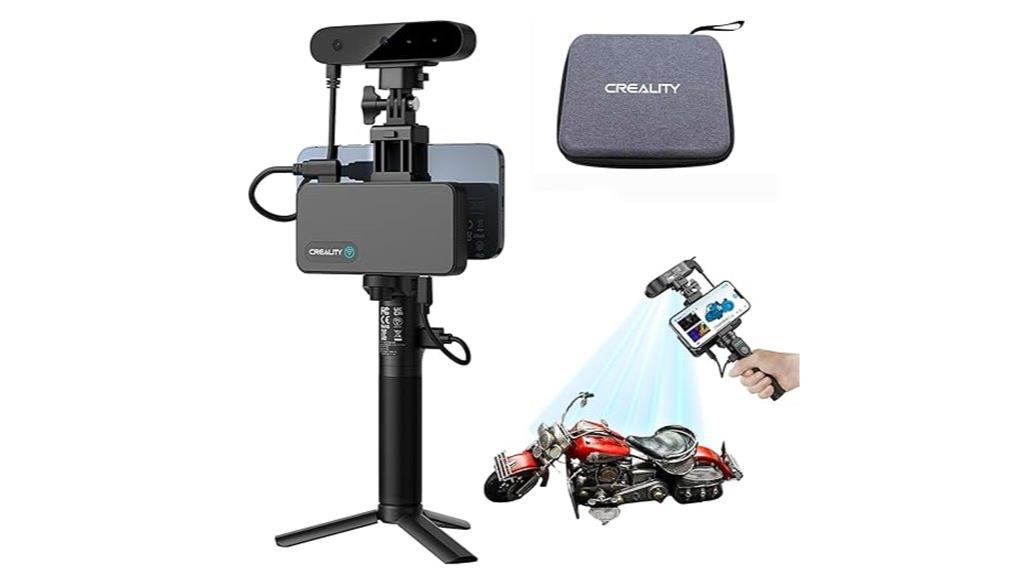
Designed for versatility and portability, the Creality CR Scan Ferret Pro stands out as an ideal choice for professionals and hobbyists who need quick, accurate, and vibrant 3D scans on the go. Weighing only 105g, it’s highly portable and performs well outdoors, even in sunlight. Its professional-grade accuracy reaches 0.1mm, capturing fine details effortlessly. The built-in 2MP RGB camera preserves full-color textures, making models realistic and vivid. With wireless connectivity via WiFi 6 or USB, setup is simple, and the device handles various surfaces without extra prep. It’s perfect for art, design, prototyping, and outdoor scanning, combining ease of use with high performance.
Best For: professionals and hobbyists seeking portable, accurate, and full-color 3D scanning for art, design, prototyping, or outdoor use.
Pros:
- Professional-grade accuracy up to 0.1mm for detailed scans
- Full-color texture capture with a built-in 2MP RGB camera for realistic models
- Wireless connectivity via WiFi 6 and USB, supporting diverse environments and devices
Cons:
- Limited USB support to Windows and Mac, with iPhone connecting only via WiFi
- No mention of advanced post-processing or editing features built-in
- Slightly limited support for scanning extremely reflective or transparent surfaces without additional preparation
3D Scanner for 3D Printing (Moose Lite)
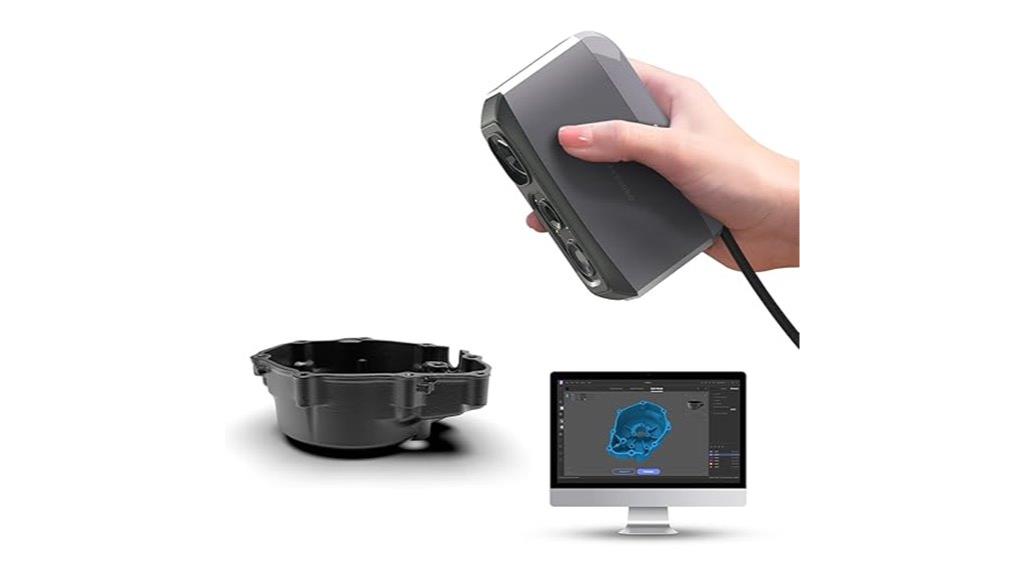
The Moose Lite 3D scanner stands out for its high-precision capabilities, making it an ideal choice for hobbyists and professionals seeking detailed and accurate models for 3D printing. It achieves 0.05mm accuracy with blue light technology and offers 0.1mm resolution, capturing intricate details. Supporting up to 100mm scan depth, it handles complex objects effectively. Its AI tracking and advanced algorithms simplify the scanning process, while the lightweight design (250g) ensures portability. Compatible with Windows and Mac, it exports in multiple formats like OBJ and STL. With fast 10FPS scanning and smart features, Moose Lite delivers quick, reliable, and high-quality 3D models for printing.
Best For: hobbyists and professionals who need high-precision, portable 3D scanning for detailed models and 3D printing projects.
Pros:
- Achieves 0.05mm accuracy with blue light technology for detailed captures
- Lightweight (250g) and portable, suitable for use anywhere
- Supports multiple file formats and integrates AI tracking for simplified scanning
Cons:
- Limited scan depth of up to 100mm, which may not suit larger objects
- Requires compatible software and hardware, possibly adding setup complexity
- Premium features and accessories may increase overall cost
Creality 3D Scanner CR-Scan Ferret Pro for 3D Printing
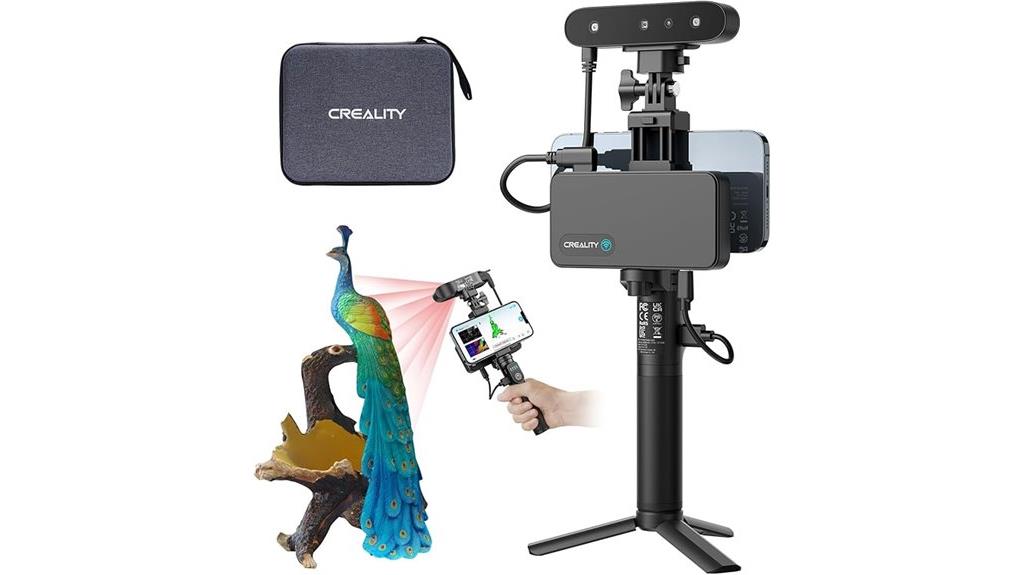
If you’re looking for a portable, high-precision handheld 3D scanner suitable for hobbyists and small-scale professionals, the Creality CR-Scan Ferret Pro stands out. Weighing just 105 grams, it’s easy to carry and use anywhere. It captures detailed, full-color scans with 0.1mm accuracy, supporting OBJ, STL, and PLY formats. Its advanced optics and intelligent algorithms perform well in various lighting conditions, even sunlight. Wireless connectivity via WiFi 6 makes pairing simple with iOS and Android devices. While it’s beginner-friendly, some users find the software a bit tricky, and post-processing may be necessary to perfect textures. Overall, it’s a versatile tool for precision 3D printing projects.
Best For: hobbyists and small-scale professionals seeking a portable, high-precision 3D scanner for detailed full-color scans and versatile applications.
Pros:
- Lightweight and portable at only 105 grams, ideal for on-the-go scanning.
- Supports multiple output formats (OBJ, STL, PLY) with 0.1mm accuracy for detailed captures.
- Performs well in various lighting conditions, including sunlight, thanks to advanced optics.
Cons:
- Software compatibility issues can be challenging, especially on Mac and older Windows versions.
- Users often experience a steep learning curve and tracking loss during scanning.
- Post-processing may be required to improve texture quality and scan accuracy.
Creality 3D Scanner Raptor Pro and Scan Bridge Wireless 3D Scanner
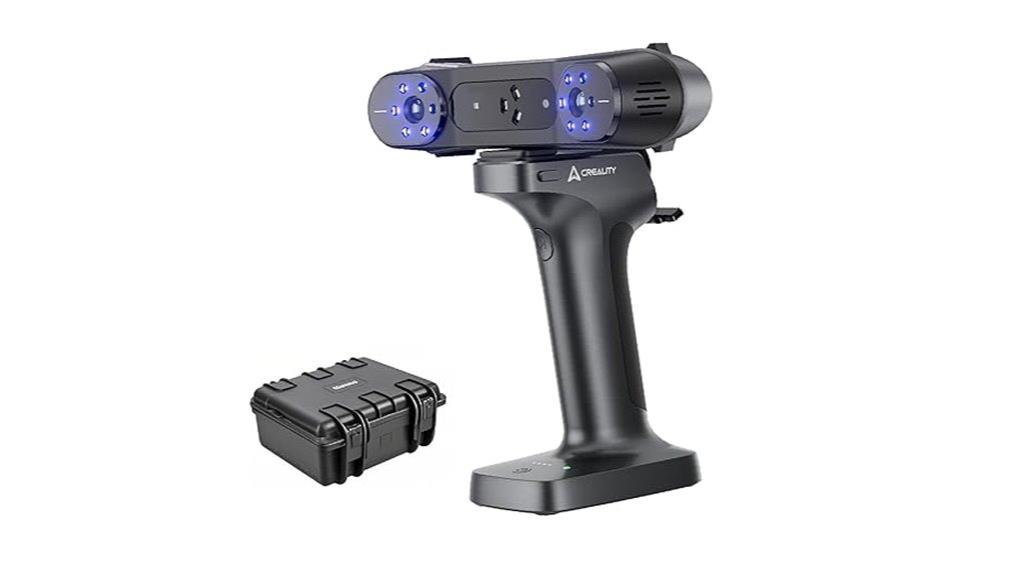
For professionals seeking a portable 3D scanner with exceptional precision, the Creality 3D Scanner Raptor Pro with Scan Bridge Wireless stands out. It offers 0.02mm accuracy, a scanning speed of 60FPS, and captures up to 660,000 points per second. The device supports full-color scans and marker-based alignment, making seamless stitching possible. Its wide object range from 5mm to 2000mm and compact, handle-equipped design enable use with smartphones and laptops in various settings. While wireless connectivity can be temperamental beyond short distances, the scanner’s high precision and portability make it ideal for detailed reverse engineering, product design, and prototyping.
Best For: professionals and enthusiasts seeking a portable, high-precision 3D scanner for detailed reverse engineering, product design, and prototyping.
Pros:
- Extremely high accuracy of 0.02mm suitable for detailed work
- Fast scanning speed of 60FPS with 660,000 points per second
- Supports full-color 3D scanning and marker-based seamless stitching
Cons:
- Wireless connectivity can be unreliable beyond short distances or with certain devices
- Software stability issues, especially on less powerful PCs, may cause crashes or timeouts
- Color mapping quality is moderate and resembles older video game graphics rather than photorealistic results
Handheld 3D Scanner for 3D Printing
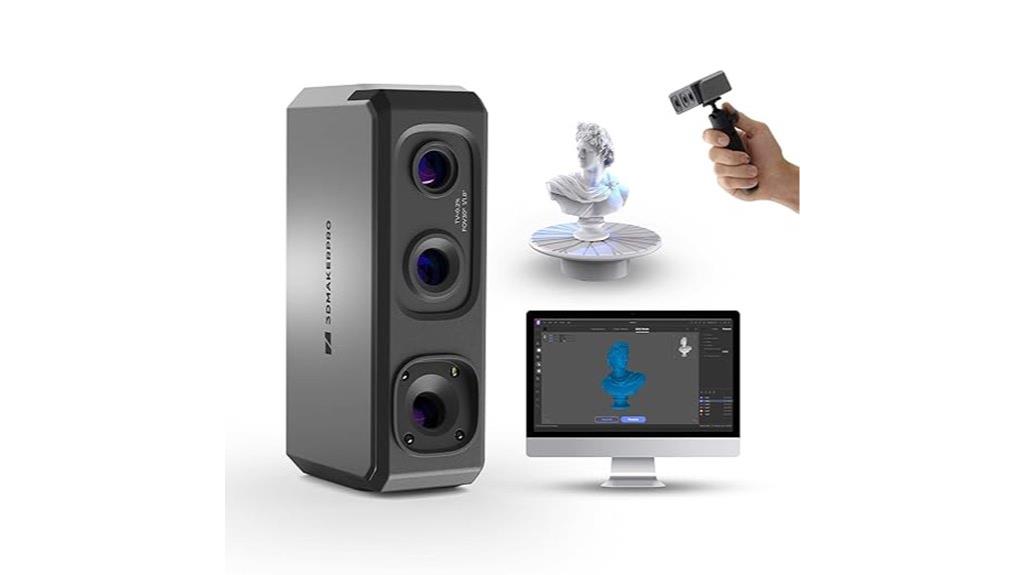
A handheld 3D scanner with a precision Blue imaging system achieving 0.02mm accuracy is ideal for hobbyists and small-scale professionals who need detailed scans of small objects or body parts. Its refined structured light technology captures incredible detail, supported by nine adjustable light levels for versatile use in different lighting conditions. With a scanning rate of 100,000 points per second, it handles body modeling, art, and prototypes effectively. Lightweight at 190g, it’s easy to maneuver, though its narrow field of view limits larger or complex objects. Perfect for detailed small-scale projects, but it requires patience and post-processing for best 3D printing results.
Best For: hobbyists and small-scale professionals seeking detailed scans of small objects or body parts for 3D printing projects.
Pros:
- Achieves high accuracy of 0.02mm with detailed capture using refined structured light technology.
- Lightweight and easy to maneuver at only 190g, suitable for handheld use.
- Supports versatile scanning with 9 adjustable light levels for different lighting conditions.
Cons:
- Narrow field of view limits larger or complex object scanning.
- Software is basic, with poor meshing quality and limited compatibility for advanced processing.
- External power supply and short cables reduce mobility, requiring additional hardware for optimal use.
Seal 3D Scanner for 3D Printer
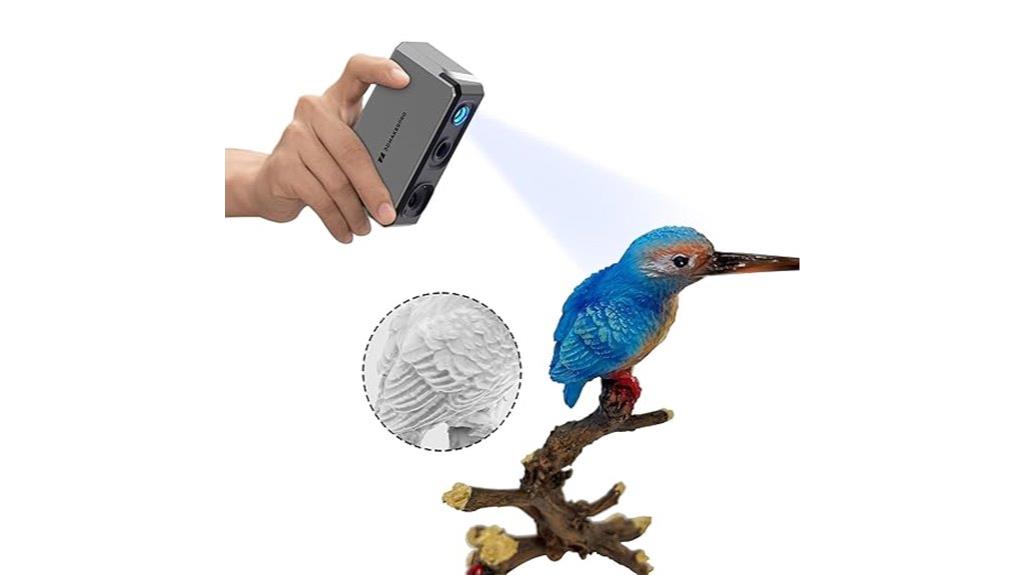
The Seal 3D Scanner stands out as an excellent choice for professionals and serious hobbyists seeking ultra-precise 3D models for printing. With 0.01mm accuracy and up to 0.05mm resolution, it captures even the tiniest details, thanks to Blue Light Encoded Structured Light technology and high-quality optical lenses. Its vibrant full-color reconstruction, powered by a 24-bit camera and flash LED, delivers realistic, detailed models suitable for various applications. Rapid scanning at 10 FPS, combined with stable, anti-shake design and user-friendly JMStudio software, makes it easy to create, edit, and prepare high-quality models for printing across different platforms.
Best For: professionals and serious hobbyists who need ultra-precise, high-resolution 3D models for printing, digital art, and detailed object capture.
Pros:
- Industry-leading 0.01mm accuracy and up to 0.05mm resolution for capturing fine details
- Vibrant full-color reconstruction with realistic textures using a 24-bit camera and flash LED
- Fast scanning at 10 FPS with stable, anti-shake design and user-friendly software for efficient workflow
Cons:
- May be costly for casual hobbyists or beginners on a tight budget
- Requires a compatible Windows or MacOS system, limiting use with other operating systems
- Advanced features and high-quality results may necessitate some learning curve for new users
Mole 3D Scanner with High Resolution and Multispectral Technology
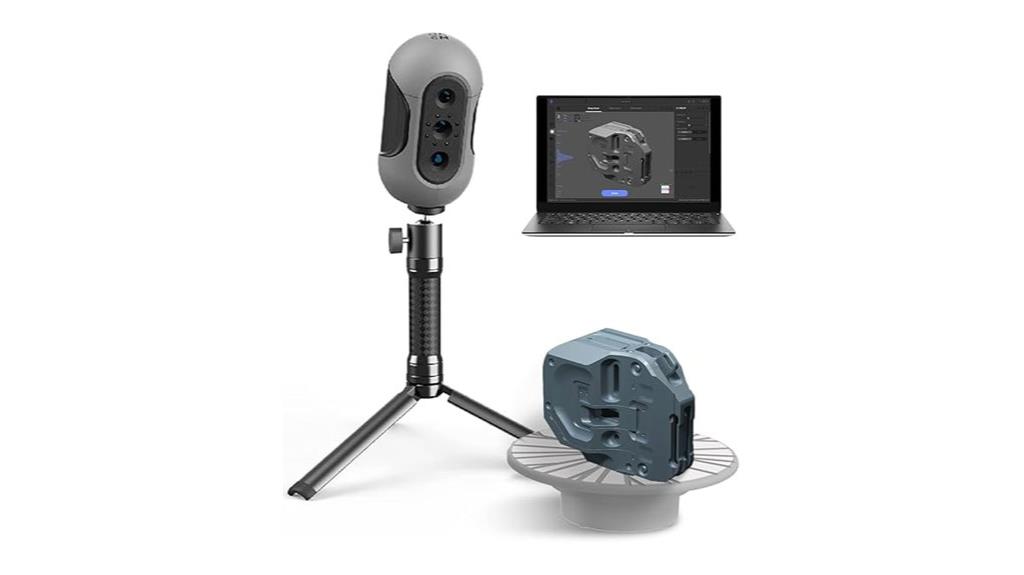
If you need a 3D scanner that delivers exceptional detail and versatility, Mole 3D Scanner stands out with its high resolution and multispectral technology. It offers 0.1mm resolution and 0.05mm accuracy, capturing intricate details with a point distance of 0.1mm. Its upgraded optical system guarantees stable, smooth scans even handheld, thanks to high-precision lenses and anti-shake modules. Supporting three scanning modes—turntable, handheld, and combined—it’s flexible for various objects. Plus, its wireless connectivity via the 3DMakerpro connector makes portable scanning easy. User-friendly software automates model optimization, making high-precision 3D capture accessible for professionals and enthusiasts alike.
Best For: Professionals, enthusiasts, and beginners seeking high-precision, versatile, and user-friendly 3D scanning solutions for detailed object recreation.
Pros:
- Exceptional resolution of 0.1mm and accuracy of 0.05mm for highly detailed models
- Multiple scanning modes (turntable, handheld, combined) for flexible use
- Marker-free, auto-calibration with AI technology simplifies setup and enhances convenience
Cons:
- Additional cost for the 3DMakerpro connector needed for wireless mobile connectivity
- Larger or complex objects may require multiple scans or adjustments for complete coverage
- Dependence on software automation might limit manual control for advanced users
Factors to Consider When Choosing High-Resolution 3D Scanners
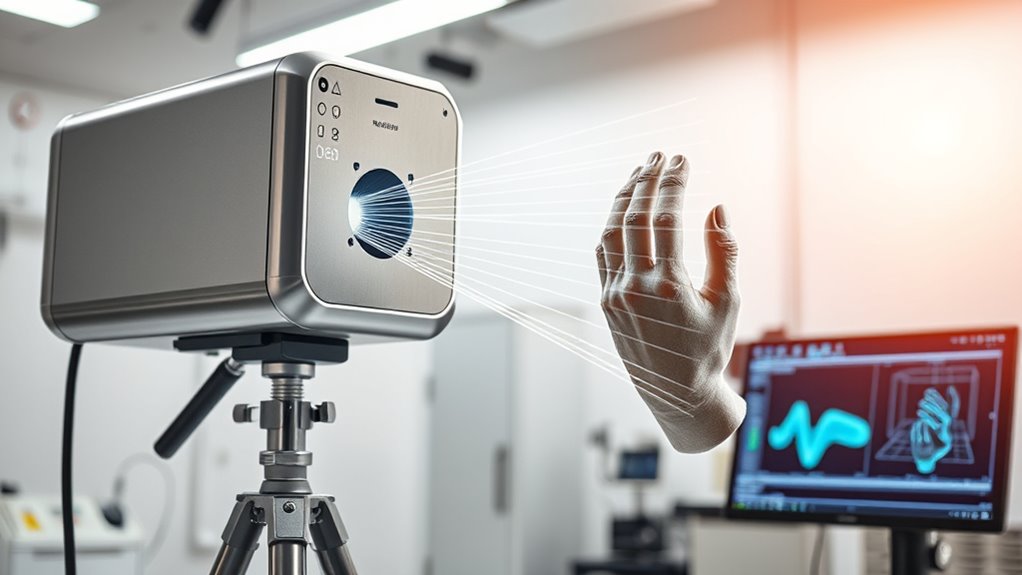
When choosing a high-resolution 3D scanner, I focus on factors like scanning precision and accuracy to guarantee detailed results. I also consider environmental adaptability, software usability, connectivity options, and whether the scanner suits the size and complexity of objects I work with. Understanding these points helps me pick a device that fits my specific needs perfectly.
Scanning Precision and Accuracy
Choosing a high-resolution 3D scanner hinges on understanding its precision and accuracy, which directly affect the quality of the captured data. Precision typically ranges from 0.02mm to 0.1mm, capturing fine details essential for applications like reverse engineering and quality control. Accuracy, often within ±0.02mm to ±0.08mm for metrology-grade devices, ensures the scanned model faithfully reflects real-world dimensions. The point cloud density, measured in points per second or per millimeter, influences surface detail and fidelity. For tasks requiring exact measurements, sub-millimeter accuracy is critical. Keep in mind that environmental conditions, surface properties, and calibration quality can impact these metrics. Prioritizing precision and accuracy helps you select a scanner that meets your project’s specific demands reliably.
Environmental Adaptability Needs
Selecting a high-resolution 3D scanner requires careful consideration of its ability to perform reliably in various environmental conditions. I look for scanners with laser or structured light systems resistant to outdoor factors like sunlight and dust, ensuring accurate readings outside controlled settings. Environmental protection ratings, such as IP certifications, are essential—they shield the device against water, dirt, and temperature swings. I also evaluate ambient light tolerance, especially for scanners using white or blue lasers, to confirm they work well under different lighting. Hardware stability matters too; sensors and laser sources should operate consistently despite wind, vibrations, or reflective surfaces. Finally, adaptive features like automatic exposure adjustments or environmental compensation help maintain high-resolution accuracy across unpredictable environments.
Software Usability and Support
A user-friendly software interface is essential because it streamlines the scanning process and reduces the learning curve, allowing even beginners to produce high-quality 3D models efficiently. Intuitive controls and clear workflows help users focus on capturing details rather than struggling with complex menus. Reliable technical support and regular updates are critical for fixing bugs, enhancing features, and guaranteeing compatibility with evolving operating systems. Compatibility with common file formats like OBJ, STL, and PLY ensures smooth integration into various 3D modeling and printing pipelines. Software stability is indispensable; crashes or errors can compromise data integrity and slow progress. Advanced features such as automatic alignment, real-time feedback, and editing tools greatly improve scan quality and user experience, making the entire process more precise and enjoyable.
Connectivity and Portability
When evaluating high-resolution 3D scanners, connectivity and portability play crucial roles in ensuring smooth and efficient scanning sessions. Wireless options like WiFi 6 or Bluetooth enable flexible data transfer and remote control, reducing clutter and setup time. Portability is essential, especially for fieldwork; lightweight designs—often under 500 grams—allow handheld use without fatigue. Compact scanners with built-in batteries support outdoor and on-the-go scanning, removing the need for external power sources. However, connectivity stability impacts scan quality; unreliable wireless links can cause lag or disconnections, so dependable protocols are fundamental for uninterrupted data capture. Additionally, mobile-compatible scanners with dedicated apps facilitate easier operation, letting you scan directly with smartphones or tablets across diverse environments.
Object Size and Detail
Choosing the right high-resolution 3D scanner depends heavily on the size and detail of the objects you plan to scan. For small, intricate items like jewelry or miniatures, I recommend scanners with accuracy of 0.02mm or better, which can capture fine details without losing precision. Larger objects, such as sculptures or automotive parts, require scanners that can cover more area while maintaining detail, often with adjustable resolutions. The surface complexity also matters; highly detailed surfaces need finer point spacing and higher accuracy to avoid missing subtle features. Additionally, scanners supporting multiple modes, like structured light and laser, give you flexibility across different object types. Paying attention to minimum point distance, typically between 0.07mm and 0.1mm, ensures precise reconstruction of even the smallest features.
Cost and Value Balance
Balancing cost and value is vital when selecting a high-resolution 3D scanner, as the most expensive option isn’t always the best fit for your needs. Entry-level models around $1,000 may save money initially but often sacrifice resolution, speed, or software stability, potentially leading to higher long-term costs. Conversely, professional-grade scanners exceeding $10,000 offer better accuracy and faster processing, but it’s essential to evaluate if these benefits justify the extra expense for your specific projects. To maximize value, consider factors like software capabilities, compatibility, customer support, and accessories that enhance usability. Finding the right balance ensures you invest in a scanner that meets your requirements without overspending on unnecessary features, providing a cost-effective solution that delivers the desired precision.
Frequently Asked Questions
What Is the Maximum Scanning Distance for These High-Resolution 3D Scanners?
The maximum scanning distance for high-resolution 3D scanners varies depending on the model, but most can scan from as close as a few centimeters up to around 10 meters. For detailed works, I usually stick to shorter distances, around 1 to 3 meters, to guarantee accuracy. If I need to capture larger objects or environments, I opt for scanners with longer ranges, sometimes exceeding 10 meters.
How Do Environmental Factors Affect Scanning Accuracy?
Environmental factors can critically impact scanning accuracy. I’ve found that ambient lighting, dust, and temperature fluctuations can cause reflections, distortions, or even sensor errors. Bright sunlight or dim lighting can interfere with laser or optical scans, while dust particles settle on surfaces or lenses, reducing precision. To guarantee the best results, I always optimize the environment—controlling lighting, cleaning surfaces, and maintaining consistent temperatures.
Are There Specific Software Requirements for Optimal Performance?
Software specifics critically boost scanning brilliance. I recommend using advanced, compatible software that seamlessly integrates with your scanner. Look for features like high-resolution processing, real-time rendering, and robust editing tools. Regular updates guarantee peak operation, while user-friendly interfaces speed up workflows. Compatibility with your operating system and hardware is essential. By choosing the right software, I can enhance accuracy, streamline my projects, and achieve precise, professional results every time.
What Is the Typical Learning Curve for New Users?
The learning curve for new users varies, but I’d say it’s moderate. Most scanners come with user-friendly interfaces and detailed tutorials, so I was able to get up to speed within a few days. However, mastering the full range of features might take a few weeks, especially if you’re aiming for highly precise scans. Patience and practice definitely pay off in becoming proficient with high-resolution 3D scanners.
How Do These Scanners Handle Complex or Reflective Surfaces?
These scanners handle complex or reflective surfaces quite well, thanks to advanced optical and laser technologies. I’ve found that some models use specialized coatings or scanning angles to improve accuracy. For highly reflective surfaces, I sometimes apply a temporary matte spray, which helps the scanner capture details more reliably. Overall, with the right settings and accessories, these scanners can effectively manage tricky textures and reflective materials.
Conclusion
Choosing the right high-resolution 3D scanner is like finding the perfect lens for capturing every detail with clarity. Whether you need handheld flexibility or high-precision accuracy, these options in 2025 offer something for everyone. I’ve explored the top models to help you make an informed decision. With the right tool in hand, you’ll turn your ideas into reality, just like a painter brings a blank canvas to life with each stroke.
